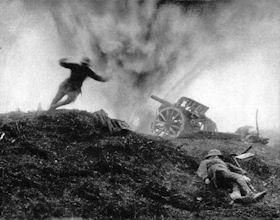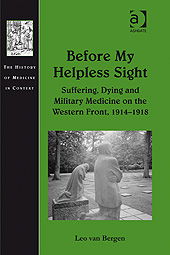BEFORE MY HELPLESS SIGHT

Tijdens de Eerste Wereldoorlog (1914-1918) stonden aan beide zijden van het front industriële grootmachten. In deze bloedige loopgravenoorlog werden voor het eerst op grote schaal machinegeweren, tanks, gas,vliegtuigen en vlammenwerpers ingezet. Het was de eerste oorlog waarin door het gebruik van de telefoon de hoge officieren niet meer zelf aan het front aanwezig hoefden te zijn. De vroeger haast spreekwoordelijke band tussen soldaat en officier viel hierdoor weg. Het individu ging in de moderne,geïndustrialiseerde oorlogvoering volledig ten onder. Daardoor vroeg die oorlog, ondanks alle machinale hulpmiddelen, vooral geestelijk nog veel meer van een soldaat, dan voorgaande oorlogen. Er is veel over de doden, zieken en gewonden van deze oorlog geschreven, maar vaak geeft men alleen de naakte cijfers of gaat de aandacht uit naar de medische stand van zaken en niet naar de patiënten.
Dr.Leo van Bergen promoveerde in 1994 op een studie naar het Rode Kruis en het vraagstuk over Oorlog en vrede. Hij is auteur van o.a ‘Zacht en Eervol, ’Lijden en Sterven in een grote oorlog’(2001) en ‘Een menslievende en nationale taak, Oorlog, kolonialisme en het Rode kruis in Nederlands Indië (2004).
Over de Engelstalige uitgave van Zacht en Eervol (Before my Helpless Sight. Suffering, dying and military medicine on the Western Front 1914-18, verschijnt in februari 2009) het volgende:
Despite the numerous vicious conflicts that scarred the twentieth century, the horrors of the Western Front continue to exercise a particularly strong hold on the modern imagination. The unprecedented scale and mechanization of the war changed forever the way suffering and dying were perceived and challenged notions of what the nations could reasonably expect of their military. Examining experiences of the Western Front, this book looks at the life of a soldier from the moment he marched into battle until he was buried. In five chapters - Battle, Body, Mind, Aid, Death - it describes and analyzes the physical and mental hardship of the men who fought on a front that stretched from the Belgian coast to the Swiss border.
Beginning with a broad description of the war it then analyzes the medical aid the Tommies, Bonhommes and Frontschweine received - or all too often did not receive - revealing how this aid was often given for military and political rather than humanitarian reasons (getting the men back to the front or munitions factory and trying to spare the state as many war-pensions as possible). It concludes with a chapter on the many ways death presented itself on or around the battlefield, and sets out in detail the problems that arise when more people are killed than can possibly be buried properly.
In contrast to most books in the field this study does not focus on one single issue - such as venereal disease, plastic surgery, shell-shock or the military medical service - but takes a broad view on wounds and illnesses across both sides of the conflict. Drawing on British, French, German, Belgian and Dutch sources it shows the consequences of modern warfare on the human individuals caught up in it, and the way it influences our thinking on 'humanitarian' activities.

Imprint: Ashgate
Illustrations: Includes 20 b&w illustrations
Published: February 2009
Format: 234 x 156 mm
Extent: 538 pages
Binding: Hardback
ISBN: 978-0-7546-5853-5
Price : £35.00 » Online: £31.50